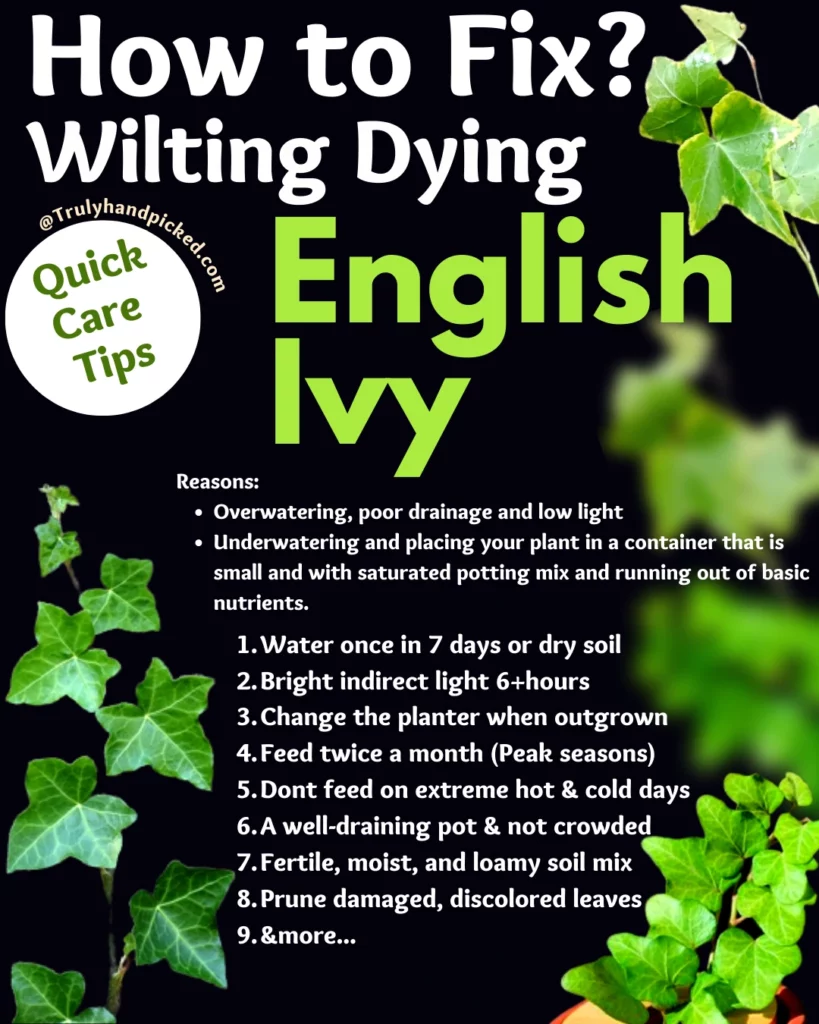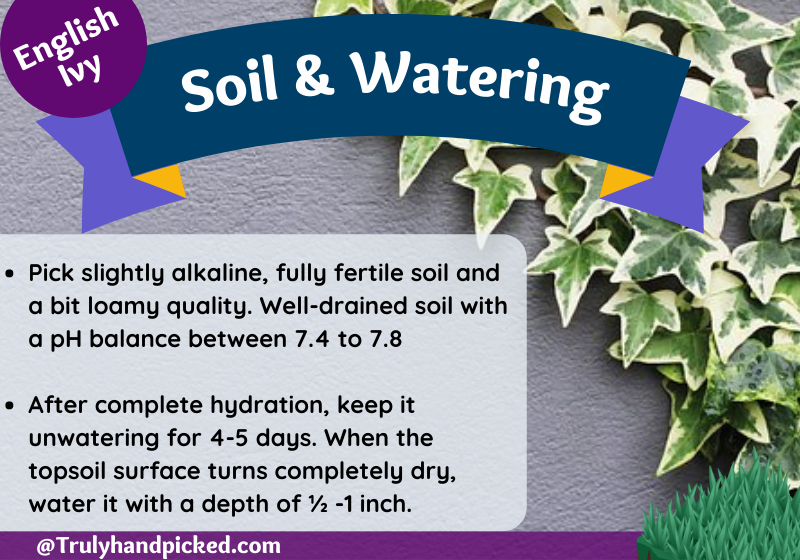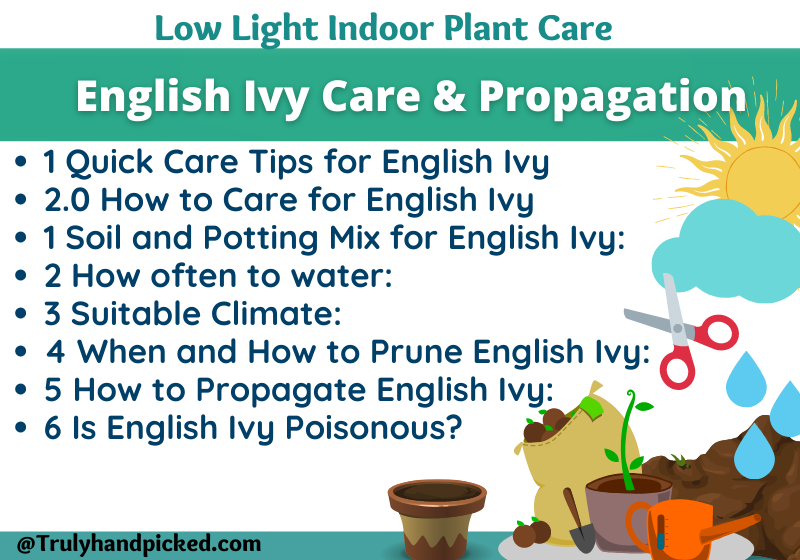Dying English Ivy: I your plant is wilting and drooping, it is mostly because of overwatering, placed in a deep low light spot for a long (not enough light).
Underwatering and even placing your plant in a container that is small and with saturated potting mix and running out of basic nutrients.
Quick fix for English ivy not growing: If your plant is not growing for long, it means of limited resources or your plant is in the wrong spot. Water only once in 7 days or when top soil is dry, place in bright indirect light to get 6+ hours of light.
A well-draining pot with a rich potting mix and pot is not crowded and has enough air circulation to breathe.
Yellowing leaves of my English Ivy: A pot without good drainage or planted in a spot where the soil remains soggy the whole time. Overwatering and root rot are one of the main reasons. And eventually, your plant leaves turn brown.
Stop overwatering and let additional water drain or evaporate. Feed your plant a general-purpose fertilizer twice a month in spring and peak growing seasons. Avoid during too hot, cold, and dry seasons.
And please note that yellow leaves mostly don’t turn green again, it’s like mostly the plant has abandoned the leaf to save energy.
Scroll down for detailed care on English ivy plants to save dying plant with brown and drooping leaves and steps on how to propagate English ivy.
Intro
English ivy is a wonderful low-light tolerant houseplant that can cultivate in plenty of ways. This species of ivy family can provide some useful health benefits too, while grown indoors.
Also, it is one of the best picks for a vertical garden. However, you can grow them normally in a small balcony garden or any indoor garden area as well.
This flowering vining plant is mostly popular for its beautiful foliage. Here is a basic guideline about how to grow an English ivy plant effortlessly at home, along with some essential caring tips.
English Ivy Care: Quick Overview on Planter & Soil Mix
- Pot Planter: Pick a classic self-watering and self-aerating round pot with a wide-open shape for the best result
- Soil: Fertile, moist, and loamy but well-drained soil with slightly alkaline quality
- Water: Water only the top surface of the soil and the plant base seems completely dry
- Fertilizer: Any balanced fertilizer, twice a month
- Sun Exposer: Bright indirect sun to shade
- Hardiness Zones: 4 to 9
Related: How to take care of dying geranium
English Ivy Quick Care Tips:
- Mist the leaves of your plant with a sprayer often, once they seem to be dry and to clean off dirt
- Dig the soil surface a little once in a while, before watering
- Wipe off the big foliage with wet cotton balls to keep them clean and healthy
- Repot the fully grown English ivy plant, whenever you find that it outgrows the current planter
- Look out for any pests or disease infestation on your plant and apply the remedy in time
- Change the place of your hanging English ivy planter, depending on the climate and seasons.
Related: How take care of brown tips on my peace lily
Detailed Ideas on How to Care for Your English Ivy
This evergreen perennial plant needs complete attention to thrive. No matter, whether you are growing an English ivy plant horizontally or vertically, the caring methods always remain the same.
An English ivy plant can climb up to 80 feet high due to its aerial rootlet. Hence, you need to provide it with adequate space to thrive properly.
Here is some info about those basic needs of a growing English ivy plant, check them below-
How to Choose Soil and Potting Mix for English Ivy:
Pick slightly alkaline, fully fertile soil and a bit of loamy quality. Make sure it has well-drained quality with a pH balance between 7.4 to 7.8. The soil should be evenly moist after the plantation, so, you can use some mulching options here.
The soil must be loose enough to drain the water, once you water your plant meticulously. Mix some organic plant food with any normal potting soil in a 1:1 ratio.
How often to water:
Once you water your English ivy plant thoroughly after the plantation, keep it unwatering for 6-7 days. When the topsoil surface turns completely dry, water it with a depth of ½ -1 inch.
Use mulch to cover the base of your plant to make the soil evenly moist for a long while. Always be certain that excess water is draining well from the bottom of your planter, before thinking of the next watering session.
Related: How to save an overwatered rubber plant
Compost and Fertilizer for the plant
An English ivy plant is a moderate feeder, so, try to feed your plant twice a month, especially during summer and spring. This vining climber plant mostly prefers any slow-release organic fertilizer rather than any readymade plant food.
Use any compost or organic matter to give your plant adequate nutrients properly. For readymade all-purpose fertilizer, go for a 20-20-20 NPK ratio for the best result.
Suitable Climate:
A growing English ivy plant can stand full sun to partial sun, but make sure it can get 6-8 hours of indirect sunlight every day.
Try to place your indoor English ivy place near a window, where it can get bright but indirect sunlight consistently. Keep the temperature between 60 to 80 degrees F with a medium to high humid climate.
To keep the shade of the foliage of a healthy English ivy plant perfect, avoid keeping it in low humidity or a temperature below 50 degrees F.
When and How to Prune English Ivy:
A healthy English ivy plant can turn bushier with proper care. So, try to trim the extra bushier part in time, before it starts hampering the healthy stems and shiny foliage of a growing English ivy plant.
Look for damaged, discolored leaves or any unhealthy foliage that has crumbled off on the edges. Prune them off with a sharp shear or plant scissor.
Try to trim off the excess stems from your plant, once they reach 2-3 inch length. This way you can keep your bushy English ivy plant always in shape.
How to Propagate English Ivy:
Propagation of an English ivy plant is even easier than normal vertical houseplants. You can do it with the healthiest stem from your pruning parts if you want.
Otherwise, cut off a fully thriving stem out of a vigorous plant with approximately 4-5 inch length. Now, let’s learn how to do it in the right way-
- Take a glass bowl or a container with some distilled water and place the cutting over the container
- Let the bottom submerge into water and keep it in a warm place, where it can get full humidity
- Wait till the roots grow from the bottom and check its progress after every 1-2 days vigilantly
- Once the roots appear from the bottom, plant the cutting into a planter prepared with potting mix and give proper care to let grow healthily.
Do you love peace lily too? then check out ways to propagate and care for peace lily plants.
Is English Ivy Poisonous?
Like other beautiful houseplants, an English ivy plant is not that much toxic to humans. But you must not eat or ingest any part of this plant ever.
You must remember that an English ivy plant is not edible. Thus, you should not eat or inhale foliage, stem, or any part of this plant ever. Otherwise, it may give you some unavoidable serious stomach issues.
An English ivy plant can be poisonous for house pets and children sometimes. If your kids (especially, those who are younger than 5 years) or house pets like cats or dogs, or rabbits, eat any leaf or stem of English ivy, try to take some medical help immediately.
FAQ:
Can English Ivy Grow in Water?
An English ivy plant can easily grow in water. You initially propagate an English ivy plant in water, try to skip the repotting part in this regard, and you can continue the whole growing session consistently in the water here.


